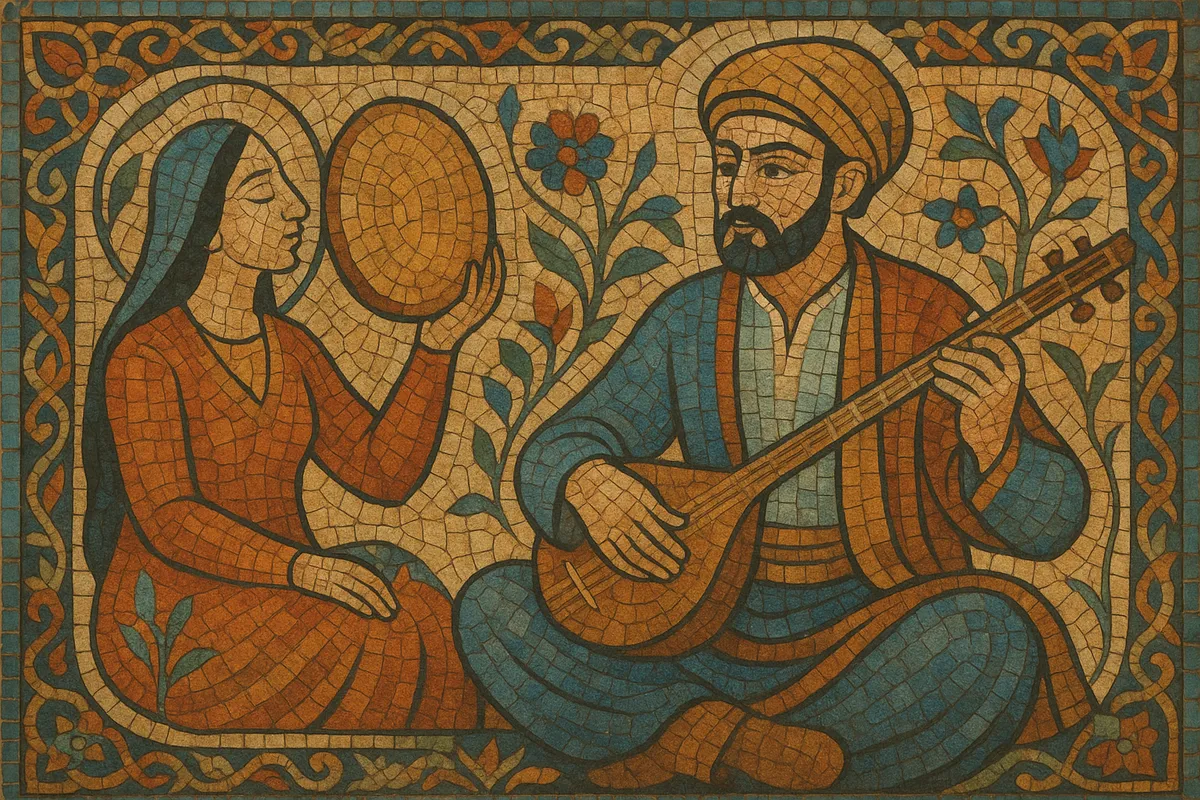Persian folk music refers to the diverse local song and dance traditions of Iran’s Persian‑speaking heartland and adjacent Iranian cultural regions, preserved mainly through oral transmission.
It is strongly modal, uses microtonal inflections (koron and sori), and favors heterophonic textures where multiple instruments/voices ornament the same melody together. Typical forms are strophic songs, narrative ballads, dance tunes, lullabies, work songs, and spiritual/devotional pieces.
Instrumentation varies by region but commonly includes voice with tahrir (ornamented melisma), long‑necked lutes (dotar, setar, tar, tanbur), bowed kamancheh, santur, ney, and regional winds (sorna/zirna, ney‑anban). Percussion such as daf, tombak, dohol, dayereh, and dammam underpins dance meters—especially 6/8—alongside additive meters like 5/8 and 7/8.
While related to the courtly/classical dastgāh tradition, Persian folk repertories keep distinctive local maqams, rhythms, dialects, and poetic forms (from ghazal‑like love lyrics to epic and ritual texts), making them essential to Iran’s cultural identity.
Persian folk music predates written history and reflects layers from pre‑Islamic Iran (including bardic gōsān traditions) through the Islamic era. Oral transmission in villages, tribal confederations, and urban neighborhoods preserved epic storytelling (naqqāli), ritual/seasonal songs, and regional dance repertoires.
From the 1500s to the 1800s, courtly and urban classical practices (dastgāh) coexisted with local folk idioms. Trade and migration along the Persianate cultural sphere facilitated exchange with Kurdish, Azeri (āshiq), Baluchi, and Central Asian musics. Folk musicians maintained distinct regional modes and meters while absorbing poetic conventions from classical Persian literature.
In the early–mid 1900s, radio and recording in Tehran began featuring regional songs, while researchers and collectors documented local styles (e.g., Khorasan dotar epics, Luri/Bakhtiari airs, Gilaki/Mazandarani songs, southern Persian Gulf bandari). Folk repertories increasingly appeared on urban stages and in state cultural programming.
Despite shifting cultural policy, provincial arts centers, festivals, and independent ensembles kept regional traditions active. Master performers (e.g., dotar and tanbur players) trained younger musicians, and ethnomusicological fieldwork expanded archives. Diaspora artists introduced Persian folk idioms to world‑music audiences.
Contemporary ensembles (e.g., Rastak, Lian, Shanbehzadeh) present region‑specific sets with modern staging, while prominent soloists adapt folk material within classical or world‑fusion frames. Today the tradition balances preservation (authentic dialects, instruments, dances) with innovation (new arrangements, cross‑regional suites, and global collaborations).
Decide on a regional idiom (e.g., Khorasan, Luristan, Mazandaran/Gilan, Kurdistan, Bushehr). Select a local mode/maqam related to the Persian dastgāh family or regional variants (e.g., Segāh with a neutral/koron third; Bayāt‑e Tork‑like contours in some northern styles). Treat the tonic and finalis as focal tones and allow microtonal inflection (koron/sori) on key degrees.
Compose a single, memorable melody and realize it heterophonically: voice and instruments perform the same line with individual ornamentation (grace notes, slides, mordents, trills). For vocals, apply tahrir (ornamented melisma) tastefully at cadences or sustained notes. Use drones or pedal tones (kamancheh/santur/ney) to anchor the mode.
Pick a characteristic meter: 6/8 for many dance songs (including southern bandari grooves), 7/8 (3+2+2) or 5/8 in some Kurdish/Luri tunes, or free/recitative openings for narrative songs. Common forms are strophic with refrains; introduce a short instrumental prelude or interlude (tasnif‑like) between verses.
Core options include: voice; dotar, setar, tar, tanbur (plucked lutes); kamancheh (bowed); santur; ney. Add regional colors: sorna + dohol for outdoor/wedding music; ney‑anban (bagpipe) and dammam in the south; daf/dayereh for trance/devotional pieces. Tombak (zarb) supports nuanced grooves in intimate settings.
Set texts in local dialects or Persian, drawing on folk subjects (love, migration, seasons, pastoral life) or mystical poetry. Maintain clear imagery and repetition for communal singing. Align syllabic stress with rhythmic accents; let cadences land on the mode’s focal tones.
Begin with a free‑meter introduction (avaz‑like) to establish the mode, then move into the dance rhythm. Layer percussion gradually; cycle through verses with instrumental replies. Encourage call‑and‑response between lead voice and chorus or between melody instrument and voice. Conclude with a tightened reprise or a faster dance coda.


